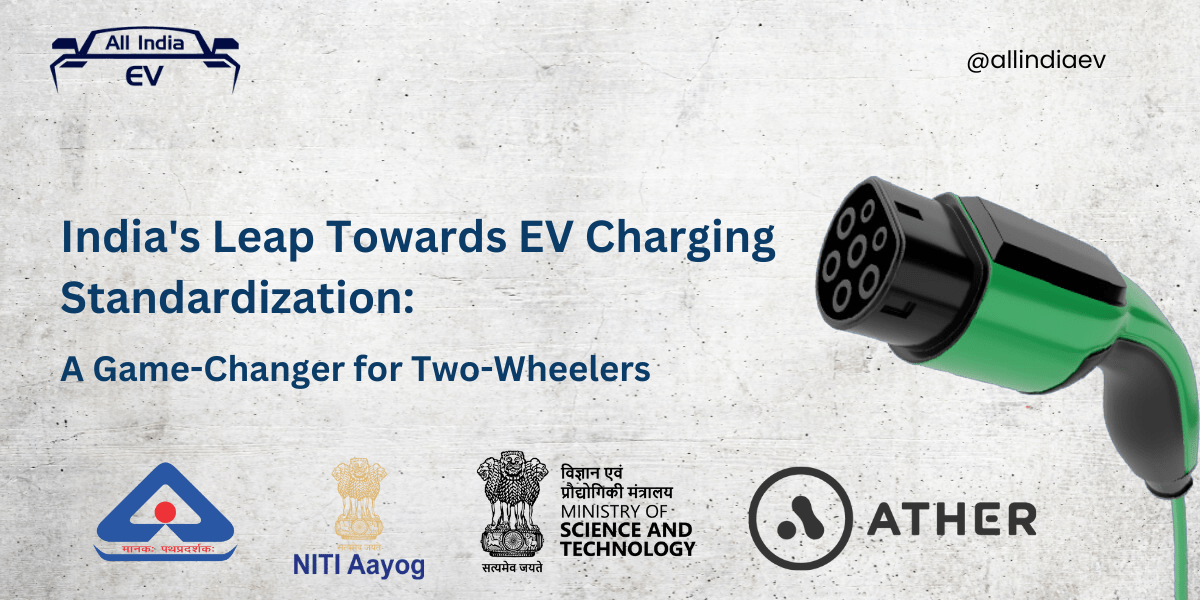
India’s Leap Towards EV Charging Standardization: A Game-Changer for Two-Wheelers
India’s journey towards becoming an electric vehicle (EV) powerhouse has seen a significant milestone. With the introduction of a new indigenous EV charging standard for two-wheelers, the nation is poised to address some of the challenges hindering the mass adoption of EVs. Let’s delve into why this is a pivotal moment for India’s EV ecosystem.
The Current EV Charging Landscape in India
India’s public EV charging infrastructure is still in its nascent stages. Compounding this challenge, various manufacturers have adopted their own unique charging connectors.
Recently, the Bureau of Indian Standards (BIS) greenlit an indigenous AC and DC combined charging connector standard tailored for light electric vehicles (LEVs) like scooters, bikes, and rickshaws.
This initiative, named ISI7017 (Part 2 / Sec 7): 2023, is a collaborative effort involving NITI Aayog, the Department of Science and Technology, Ather Energy, and other key players from the government and industry.
Why This New Standard is Revolutionary
This homegrown charging standard is a global first, integrating both alternating current (AC) and direct current (DC) for LEVs. While combined AC and DC charging standards for cars are prevalent globally, such as Europe’s Combined Charging System (CCS), this is a pioneering move for two-wheelers. The beauty of a combined charging standard lies in its interoperability, ensuring compatibility across various EV models and charging infrastructures.
The Imperative for a National Standard in India
Currently, Indian EV manufacturers aren’t bound to a specific charging connector standard. This has led to a fragmented ecosystem, with companies like Ola Electric, Ather Energy, and Ultraviolette Automotive each adopting distinct charging standards. This diversity, while innovative, poses challenges for public charging stations, exacerbating the “range anxiety” among EV users.
The newly approved standard seeks to harmonize AC and DC charging. However, it stops short of making it mandatory for manufacturers, a step that could further alleviate range anxiety and expedite EV adoption.
A Glimpse at Global Practices
China: Leveraging a national standard named GB/T and boasting one of the world’s densest charging station networks, China effectively addresses range anxiety concerns.
United States: While lacking a national standard, collaborations like Ford and GM adopting Tesla’s North American Charging Standard (NACS) are noteworthy.
Europe: The CCS is the dominant standard, mandated by the European Union for EV charging networks.
Japan: The CHAdeMO, introduced in 2010, remains Japan’s primary charging standard, though it’s seeing a decline in North America.
The Socio-Economic Implications for India
Having a standardized EV charging connector can have profound socio-economic benefits for India:
📢 Infrastructure Development: A unified standard can catalyze the development of public charging stations, creating jobs and fostering technological innovation.
📢 Consumer Confidence: Reducing range anxiety can boost consumer confidence, driving higher EV sales and reducing dependency on fossil fuels.
📢 Environmental Impact: Mass adoption of EVs can significantly reduce carbon emissions, contributing to cleaner cities and better public health.
📢 Economic Growth: A thriving EV ecosystem can attract investments, stimulate manufacturing, and position India as a global EV hub.
In conclusion, while the journey towards a fully electric future is long, India’s new EV charging standard is a significant stride forward. By recognizing the socio-economic benefits and addressing the current challenges, India can pave the way for a greener, more sustainable future.




